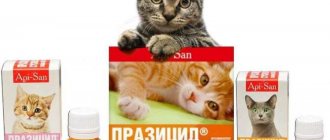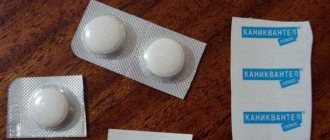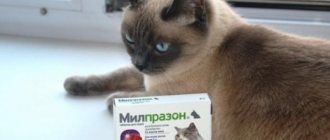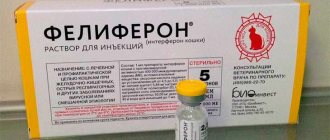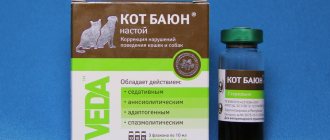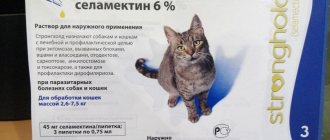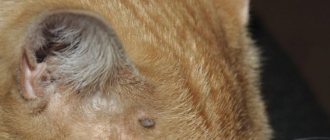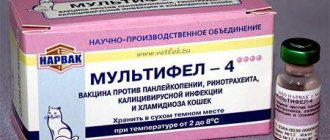| Article verified by a practicing veterinarian |
Preventive treatment of pets against helminths is mandatory item when keeping them.
Even if a pet does not go outside, it can become infected with helminths through the owner’s shoes, objects brought from the street, grass collected from the street, soil for indoor plants, etc. Some types of worms can be transmitted from pets to humans. The topic of deworming is especially relevant if there are children in the house.
In the fight against parasites, veterinary pharmacology offers a wide range of means. Let's look at the drug Prazicide for cats: how to give it, dosage, possible side effects and contraindications.
Description of the drug and properties
Before giving your cat Prazicide suspension plus, you must read the instructions.
The drug contains three active anthelmintic components - praziquantel, pyrantel pamoate, and febantel , which makes it an effective remedy in the fight against roundworms and tapeworms.
Febantel affects the vital organs of the parasite, as a result of which it dies.
Praziquantel affects the muscles of the worm, which leads to its paralysis and death . This component helps destroy helminth larvae, oocysts and eggs.
Pyrantel pamoate causes muscle paralysis in nematodes, which leads to their death.
The drug reaches its maximum concentration in the body 3 hours after administration and is effective for 12-24 hours . It is excreted from the body in the urine and feces of the animal.
Release form
Available in the form of tablets, suspensions and drops on the withers . The drug is selected taking into account the weight and age of the animal. Each release form has its own characteristics and areas of application.
The tablets are intended for adult cats. They have a yellow tint. For convenience, there is a dividing strip in the middle of the tablet. Tablets are available in blisters of 3-6 pieces. In addition to the instructions, the package includes stickers for the veterinary passport.
The suspension is used for adult cats and kittens. Prazicide in the form of a suspension is more convenient when calculating the dosage and feeding the animal. The suspension contains the following components:
- 1.5 mg praziquantel;
- 15 mg pyrantel pamoate;
- 15 mg febantel;
- Excipients.
The drug has a yellowish tint and a pleasant smell of milk chocolate. Liquid separation is allowed and must be eliminated by vigorous shaking.
For ease of use, the manufacturer includes a dispenser syringe.
There is Prazicide, produced specifically for kittens . The concentration of active substances in it will be significantly lower, but many owners note its low effectiveness. However, when treating children, greater attention should be paid to their safety.
The drug is stored at temperatures from 0 to 250C away from human food and animal feed. The shelf life of the drug is 2 years.
Reviews from veterinarians
Maria, veterinarian
Based on customer reviews, I can say that Prazicide works effectively. In any case, there were no repeated complaints after its use. I always recommend it: the suspension is a convenient form, moreover, it has a sweetish taste, and animals do not resist too much when administered orally. Suitable for cats and dogs, which is also convenient when there are two shaggy friends in the house. The price is reasonable, which also matters: anthelmintic drugs should be affordable.
Dmitry, veterinarian
If you follow the norm and dosage schedule, there are no problems with the drug. The owners of my patients like that the package contains a syringe dispenser - it is very convenient: the scale on the dispenser allows you to accurately dial in the required volume even for the smallest kittens.
Indications for use
Prazicide has shown high effectiveness in the fight against gastrointestinal parasites . The drug is prescribed to animals from 3 weeks until they reach old age.
The suspension is used for prophylaxis and medicinal purposes for:
- cystosis – caused by tapeworms (tapeworms, alveococci, echinococci, taeniasis);
- trematodosis - caused by worms from the class of flukes;
- nematode - caused by roundworms (Toxocara, whipworm, Trichinella, roundworm, hookworm);
- nematozocystosis - caused by a mixed type of invasion.
At the initial stage, helminthic infestation may not manifest itself at all, or the symptoms will be subtle. The most common signs of infection are:
- gastrointestinal disorders without an obvious cause (alternating constipation and diarrhea, vomiting);
- refusal to eat or excessive increase in appetite;
- cough;
- yellowness of the mucous membranes and enlargement of the liver;
- symptoms of anemia, especially dangerous for kittens;
- there is itching in the anal area;
- presence of blood in feces;
- signs of severe intoxication;
- termination of pregnancy or premature birth;
- bloating;
- rickets and other symptoms of developmental disorders in kittens.
It is strictly not recommended to self-medicate and, if there are signs of helminthic infestation, to give anti-worm medications without conducting clinical tests. Therefore, if ailments are detected, it is recommended to take the animal to a veterinarian for an accurate diagnosis. After it, the doctor should give recommendations on treatment, frequency of administration and dosage. The numbers below are for reference.
What to replace it with?
If your pet needs to change the drug, you can purchase Prazicide Plus suspension.
The Russian company Api-San produces various medicines for parasites, so if it is impossible for pets to use the medicine “Dirofen”, veterinarians can prescribe Prazicide Plus instead, also for. It is a suspension that is suitable for both adult and small kittens. The composition of Prazicide includes: pyrantel, febantel, praziquantel and various excipients. Another replacement for Dirofen could be Helmimax, which is based on 1 mg of moxidectin and 20 mg of praziquantel. It acts against nematodes, cestodes and mixed invasions, and is also an excellent prevention of dirofilariasis. In what dosage to use this or that antiparasitic drug for a cat, you should check with your veterinarian.
Directions for use and dosage
How to give Prazicide for cats for preventive purposes
For adult cats
The drug is given once every 3 months according to the schedule recommended by the veterinarian.
The drug is also recommended before vaccination (not a mandatory requirement), when crossing the border, before exhibitions, etc.
Kittens
For prevention purposes, babies are given a suspension at the age of 3 weeks before vaccination .
How to give Prazicide suspension for cats during treatment
For adult cats
In mild cases of helminthic infestation, the drug is given once and this may be sufficient.
Most often, veterinarians use a standard regimen - 2 times with a break of 10-14 days .
In severe cases of infestation, the drug is given for 3 days . After 2 weeks, re-application is required.
Kittens
If there is a helminthic infestation in kittens, the treatment regimen includes taking the drug and repeating it every other week . If there are several kittens and they are kept together, then twice the application will be required at a two-week interval.
How to give Prazicide suspension for cats: dosage
For adult cats
For the prevention and treatment of adult cats, the drug Prazicide suspension 7 ml is used. According to the instructions, a single dose in both cases is 1 ml per 1 kg of animal weight .
Kittens
For the prevention and treatment of kittens, it is recommended to use the drug Prazicide Plus 5 ml, available in the form of a suspension. According to the instructions, a single dose is 1 ml per 1 kg of animal weight.
Danger of Invasive Infections
According to the World Health Organization (WHO), every second person on the planet is annually infected with one of the types of helminths (the general name for parasitic worms) that circulate in nature, entering the body of humans and animals from soil or water.
Parasites move from one host organism to another, for example, on the legs of insects (mechanically), through the organism of an “intermediate host”, in which they do not reproduce, but only spend one cycle to get to the desired “destination”.
For example, echinococci are tapeworms that parasitize transit in the body of cats and dogs, and humans are an intermediate carrier. Helminths are also transmitted by contact, through food and soil. At the same time, roundworms remain viable in the soil for up to 3 years even at subzero temperatures: they are also resistant to ultraviolet exposure.
Parasitic worms cause irreparable harm to the host body:
- Feeding on blood causes anemia;
- Destroys the intestinal walls and thereby causes secondary infections;
- Ascaris larvae, rising into the bronchi, can cause suffocation in large concentrations;
- The waste products of helminths cause severe forms of intoxication in the recipient's body.
All of the above is a good reason for regular prevention and treatment of helminthiasis not only in kittens, but also in all inhabitants of the house, especially in children.
Be sure to read:
TOP 5 drugs for the treatment of ear mites in cats: prices and reviews
Prevention consists of observing standard hygiene standards. Kittens, starting from the age of three weeks, switch to complete independent food, and you need to pay close attention to its quality: do not feed raw foods (without heat treatment), do not give unboiled or untreated water.
Given the excessive curiosity and activity, as well as the interest of children in furry pets, the premises should be thoroughly disinfected regularly: helminth larvae can enter the house with shoes and outerwear, with the help of insects.
Once every three months, kittens need to be given antiparasitic drugs for prevention.
Recommendations for the method of feeding with suspension
- Deworming is carried out on healthy, not pregnant or lactating animals.
- 2-3 days before deworming, it is recommended to treat the animal against ectoparasites.
- Before use, the suspension must be shaken until smooth.
- It is advisable to give the drug in the morning with the first feeding.
- The drug can be mixed with food provided that the animal eats the prescribed amount of suspension.
- The suspension can be injected dropwise onto the root of the tongue using a measuring syringe.
- There is no need to follow a diet or rinse the intestines before taking it.
The suspension can be given using a syringe without a needle
Contraindications
Before giving Prazicide suspension plus to a cat, it is necessary to study the contraindications.
According to the instructions, the suspension is not recommended for:
- exhaustion of the animal;
- individual intolerance to components;
- respiratory infections;
- rehabilitation period;
- pregnancy;
- lactation;
- reaching the age of less than 3 weeks.
In case of urgent need and under the supervision of a physician, the drug can be taken with caution in cats 21 days before birth, as well as after 14-21 days of lactation.
Side effects and overdose
If you notice the following symptoms in your pet after taking the drug, it should be shown to a doctor as soon as possible.
Possible side effects
Side effects from taking Prazicide are extremely rare. Some cats may react with the following conditions:
- diarrhea;
- vomiting;
- excessive salivation;
- allergies.
These manifestations usually go away on their own as soon as the drug is no longer used.
If, when using drops, the animal experiences skin irritation, the product should be washed off immediately and, if necessary, antiallergic medications should be given.

